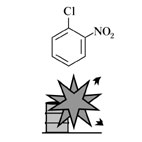| Case Name |
Explosion of an o-nitrochlorobenzene melting drum caused due to a temperature rise caused by reflux piping blockage |
| Pictograph |

|
| Date |
October 15, 1986 |
| Place |
Onoda, Yamaguchi, Japan |
| Location |
Pharmaceutical factory |
| Overview |
On October 15th, 1986, for the production of 1-hydroxybenzotriazole at a pharmaceutical factory in Yamaguchi prefecture, o-nitrochlorobenzene was charged into a melting drum and was heated to 120 °C, and hydrated hydrazine was dropped into the drum. Although dropping was stopped at 124 °C, generated o-nitrophenylhydrazine started an exothermic decomposition at about 110 °C to produce 1-hydroxybenzotriazole, and it started to explosively decompose at about 160 °C. Approximately 1.5 cubic meters of a tarry black liquid spouted out from the reactor, and it reached a point 50-60 m away from the factory. |
| Incident |
An explosion in a reactor due to temperature rising. |
| Processing |
Manufacture |
| Individual Process |
Reaction |
| Process Flow |
Fig2.Unit process flow
|
| Chemical Reaction |
Other |
| Chemical Equation |
Fig3.Chemical reaction formula 1
|
| Substance |
o-nitrochlorobenzene |
| Type of Accident |
Explosion, leakage |
| Sequence |
A melting drum exploded with a loud sound at a factory for manufacturing a pharmaceutical intermediate hydroxybenzotriazole, and near-by buildings were damaged. The walls and the upper half of the building where the reactor was installed were totally destroyed, and the drum itself was found at the sea-bottom 70 m away from the building. Before the explosion, a temperature rise in the drum was observed. Yellowish crystals of o-nitrochlorobenzene were found in the clogging reflux piping between the drum and a flow meter. O-chloroazobenzene and its hydrazine derivatives, which were not expected to be produced by a normal chemical reaction, were found in samples taken from the site |
| Cause |
Yellowish crystals of o-nitrochlorobenzene were generated by supercooling, and the crystals were deposited in the reflux piping at the part between a melting drum and a flow meter. A reflux stopped completely and temperature of the drum rose. O-nitrophenylhydrazone, which was obtained by a reaction using the melting drum, started to thermally decompose and changed to hydroxybenzotriazole at a high speed, and exploded. |
| Countermeasures |
1. Mechanical countermeasures: The melting drum which was also used for a reactor should be equipped with an unusual pressure and temperature detector and an appropriate alarm system. It also should be equipped with a fail-safe system when a temperature rise inside the reactor is noticed, such as to stop heating or release the contents in the reactor into an appropriate coolant.
2. Utility countermeasures: The temperature of coolant should be strictly controlled so as not to fall below the freezing point. |
| Knowledge Comment |
At a system where excessive cooling must be inhibited, one approach to ensure absolute safety would be setting the lowest limit of the coolant temperature and preparing facilities and operations that do not work under that temperature. |
| Background |
1. A reflux stopped because the reflux piping was blocked due to supercooling.
2. The cause of supercooling was considered to be a failure in flow and/or temperature control of cooling water.
3. Use of coolant that can produce a temperature below the freezing point might have been a process design failure. |
| Incidental Discussion |
There are two causes of a temperature rise in a reactor or a melting drum which is operated under a reflux condition. One is pressure rising due to blocking of a condenser and/or overhead piping. The other is a heavier component at the bottom caused by stopping of a reflux. In this case, the possibility of stopping of a reflux is stronger. |
| Reason for Adding to DB |
Example of explosion influenced due to reflux pipe blockage |
| Scenario |
| Primary Scenario
|
Carelessness, Insufficient Understanding, No Connection of Thinking between Freezing Point and Condenser, Organizational Problems, Inflexible Management Structure, Insufficient Education/Training, Planning and Design, Poor Planning, Condenser Designed below Freezing Point, Non-Regular Action, Emergency Action, No Action at Abnormal temperature Rise, Bad Event, Mechanical Event, Plugging, Bad Event, Chemical Phenomenon, Abnormal Reaction, Secondary Damage, External Damage, Explosion, Loss to Organization, Economic Loss
|
|
| Sources |
Masamitsu Tamura. Masahide Wakakura. O-nitrochlorobenzene explosion. Reaction dangerous- Accident case and analysis - p.131(1995)
|
| Number of Injuries |
1 |
| Physical Damage |
Factory walls and a roof were severely damaged. A melting drum and an agitator blew off 70 m away into the sea. |
| Field |
Chemicals and Plants
|
| Author |
YOSHINAGA, Jun (Graduate School of New Frontier Sciences, The University of Tokyo)
TAMURA, Masamitsu (Center for Risk Management and Safety Sciences, Yokohama National University)
|
|